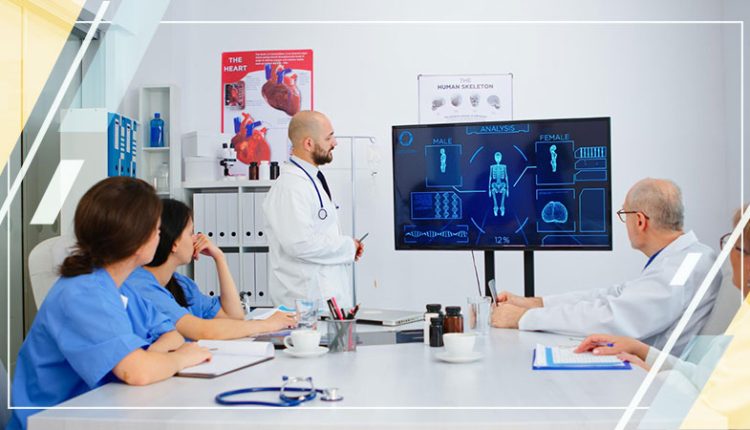Visualization plays a crucial role in the modern lifestyle. Liquid Crystal Displays (LCDs), Augmented Reality (AR), and Virtual Reality (VR) are revolutionizing the way humans visualize today. However, these technologies are not well suited for application in every sector. The need for displays or visualization varies in every sector. For instance, in the healthcare sector the need for displays or monitors is very different. LCDs, AR, and VR will not be able to suffice the needs of healthcare providers.
There are various specialized medical monitors available in the market, with each one catering to a specific healthcare need. In order to select the right medical display for application in the healthcare sector, it is crucial to understand how these displays are different from industrial or consumer displays. In this article, let us have a look at the types of medical displays available and how each one of them differs.
What is a Medical Display?
A monitor that suffices the high and specific demands of medical imaging is referred to as a medical display. Following are the particular specialties that the medical monitors are designed to serve:
- Radiology
- Breast imaging
- Surgery
- Digital pathology
- Dentistry
Displays used for medical purposes have embedded special image-enhancing technologies. These image-enhancing technologies are integrated in the display for the following reasons:
- The display should have consistent brightness throughout its lifetime.
- The images displayed should be noise-free.
- The display should offer ergonomic reading.
- It should comply with DICOM and other medical standards.
The Importance of Medical Displays in Healthcare
Medical monitors serve as the backbone of the healthcare sector for processing and displaying medical images. These displays are leveraged by radiologists and medical physicists. Clinical review monitors offer comprehensive, indepth, and accurate patient care.
Types of Medical Monitors
Following are the types of medical monitors that are available in the market catering to specific niches:
● Vital Sign Monitors
Monitors that examine the core vitals of the body like oxygen saturation levels, blood pressure, temperature, respiration rate, ECG, and pulse are vital sign monitors. For instance, finger oxygen monitors and pulse oximeter monitors are vital sign monitors. These devices help users to track their oxygen saturation levels and respiration rates.
These devices allow healthcare professionals to take blood pressure readings non-invasively. Portable vital signs monitors are lightweight and enable smooth transport between rooms. The basic models do not calculate the critical levels, healthcare professionals have to additionally purchase CO2 measurements. Moreover, the basic versions of vital sign displays are not equipped for a 12-lead ECG.
Inpatient facilities and ICUs in the hospitals will have an in-depth vital sign medical display. These monitors might also be available in operating rooms or transitional rehab facilities.
● Patient Monitors
Patient monitors have similar functionalities to basic vital sign display devices. One significant difference is that a few manufacturers offer patient monitors with more functionalities. Healthcare providers can get larger screens or functionalities as an add-on.
End-tidal CO2 (ETCO2), cardiac output, anesthetic agents, and invasive blood pressure are a few critical medical monitoring that top-quality patient monitors can offer. Healthcare professionals can make the final decision based on the screen size and functionalities required. Bigger screen displays can be beneficial for its ergonomic features.
● EKG Monitors
EKG is an abbreviation for electrocardiogram. Healthcare providers can use an EKG monitor to generate an electrocardiograph. EKG monitors are 12-lead machines with an embedded touch screen or digital display.
Even the basic patient monitors can register an EKG, however, it can only offer a four to six-lead reading. In cardiology, a 12-lead reading is a standard reading accepted by various physicians. They would require a much more accurate electrocardiograph before initiating any treatment plan.
Portability, broad frequency, diagrams for electrode placements, different file formats, and management software are a few key characteristics of an EKG monitor. Hospitals that accept geriatric and pediatric cases will need a highly sensitive EKG monitor to capture accurate EKG readings for both scenarios.
Additionally, an EKG should also be capable of detecting cardiac abnormalities with accurate readings. The EKG should be able to detect abnormal heart rhythms, impaired blood flow, heart attack, enlarged heart, and electrolyte levels.
It is a very easy process to set up an EKG. The best medical displays will even allow healthcare professionals to transfer data between health portals legally.
● Capnography Monitors
Capnography monitors are the medical displays that can measure end-tidal CO2 levels. For patients on ventilators and critical respiratory illness, calculating end-tidal CO2 levels is essential. These medical monitors measure the amount of carbon dioxide a patient exhales.
In emergency units, capnography monitors provide quality indicators if the patient has any obstructive lung diseases. These types of medical displays are necessary for patients who are about to undergo surgery. Patients who need an endotracheal tube need a capnography monitor for close monitoring of their health. Measuring pulse oximeter, blood pressure, and temperature are a few other uses of this type of medical monitor.
Conclusion
Medical displays are important equipment that helps substantially minimize medical errors, optimize treatment plans, and eliminate complications. It can be a challenging task for healthcare professionals to find the right medical-grade monitors for their use.
Healthcare providers need to broaden their search and have a clear understanding of their requirements to select a reliable, efficient, and affordable medical monitor.


